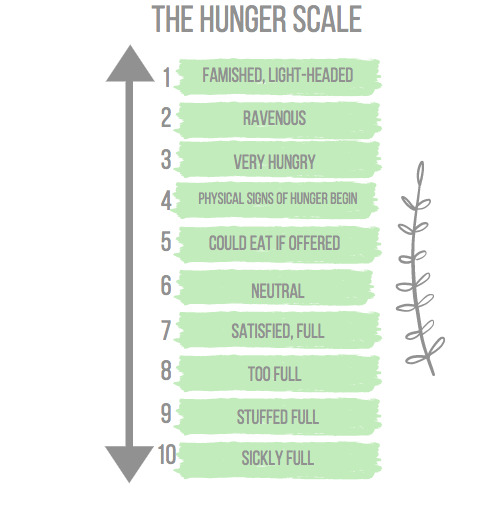Honouring your hunger is one of the most powerful things you can do for your health and sadly diet culture teaches you to try and stop yourself from feeling hungry.
The reality is, hunger is a survival mechanism, reminding you when to eat.
When you deprive or starve yourself, ignoring your hunger, you are often driven to eat past the point of comfort later on. This often leads to negative feelings both physically and emotionally.
There are effective ways to help honour and respect your hunger, using the Hunger Scale. I have seen this work well with clients.
Before we launch into how to use the Hunger Scale, let’s understand more about exactly what hunger is.
What is hunger?
Hunger is complicated and it can be difficult to know what kind of hunger you are feeling. There are four types of hunger:
- Physical hunger is what you feel when your body is running low on fuel. It increases gradually, is not immediate and results in a sense of satisfaction when honoured
- Emotional hunger is different in that it is what you feel when you want comfort from food. You may feel sad, angry or bored and seek food to help aid these feelings
- Taste hunger is what you feel when you are craving a particular taste or food
- Practical hunger occurs when you eat when it is convenient and habitual for you – for example eating a meal before you leave for work even if you do not feel physically hungry because you know you will feel hungry later
It is often not as simple as saying “oh just start recognising when you’re hungry and all will be well”. Understanding and identifying hunger can be difficult, especially after long periods of suppression!
That’s where the Hunger Scale comes in.
What is the Hunger Scale?
When you’re asked to consider your hunger level it can vary frequently, sometimes hourly, sometimes every few minutes!
Using a tool like the Hunger Scale can help you to identify where your hunger is sitting. This scale is a 1-10 range going from extreme hunger to extreme fullness.

This tool has been effective in helping some of my clients identify their level of hunger, without judgement, and to then respond accordingly.
How to use the Hunger Scale
After times of ignoring your hunger, it will likely not be easy to recognise these cues and identify hunger again. If you are feeling this way, it may be helpful to spend time tuning into what physical hunger feels like for you – this may include feeling an empty stomach, growling, headaches, grumpiness or weakness. Bringing attention to such feelings will allow you to become familiar, once again, with what hunger feels like for you.
Try and identify what hunger range feels the most comfortable for you to begin eating. When working with clients I find most people identify that this is around a 4 or 5.
During your meal pause and reflect on how you’re feeling as the eating experience continues.
As you start to feel full and satisfied tune in to how you would rate this feeling on the Hunger Scale. From experience, I have found most people feel comfortable post-meal sitting around a 6 or 7.
It’s important to be gentle with yourself as you navigate the Hunger Scale. There will be times that you find yourself ravenously hungry or sickly full and that is absolutely ok!
Both of these experiences can be a helpful way of learning about your own body. This is a process and not something that we need to be perfect. It is about tuning into your body’s innate signals and responding accordingly – which can take time!
Tips to honour your hunger
- Print out the Hunger Scale and have it somewhere that you can glance at it when you need
- Meal preparation and planning – It can be helpful to organise your meals and snacks ahead of time. This can help you to avoid getting ravenously hungry and eating past the point of comfortable fullness
- Trust your body and trust your hunger – this is not an easy thing to do when we have been taught for so long that food and hunger are the enemies. One of the best things you can do for your health is to respond to your own individual needs, rather than restricting or ignoring them
If you are looking for some meal prep ideas to make sure you have food ready when hunger strikes, download my free Plant-Based Winter Recipe Book! It’s full of scrumptious plant-based meal options that are perfect for the colder months.




 Prev Post
Prev Post